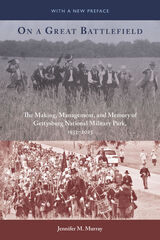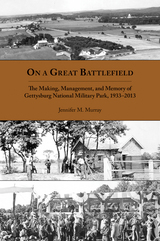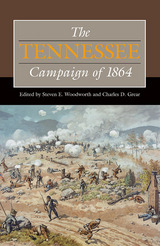3 books about Murray, Jennifer M.

On a Great Battlefield
The Making, Management, and Memory of Gettysburg National Military Park, 1933–2013
Jennifer M. Murray
University of Tennessee Press, 2023
Of the more than seventy sites associated with the Civil War era that the National Park
Service manages, none hold more national appeal and recognition than Gettysburg National
Military Park. Welcoming more than one million visitors annually from across the
nation and around the world, the National Park Service at Gettysburg holds the enormous
responsibility of preserving the war’s “hallowed ground” and educating the public, not
only on the battle, but also about the Civil War as the nation’s defining moment. Although
historians and enthusiasts continually add to the shelves of Gettysburg scholarship, they
have paid only minimal attention to the battlefield itself and the process of preserving,
interpreting, and remembering the bloodiest battle of the Civil War. In On a Great Battlefield,
Jennifer M. Murray provides a critical perspective to Gettysburg historiography by
offering an in-depth exploration of the national military park and how the Gettysburg
battlefield has evolved since the National Park Service acquired the site in August 1933.
As Murray reveals, the history of the Gettysburg battlefield underscores the complexity
of preserving and interpreting a historic landscape. After a short overview of early
efforts to preserve the battlefield by the Gettysburg Battlefield Memorial Association
(1864–1895) and the United States War Department (1895–1933), Murray chronicles the
administration of the National Park Service and the multitude of external factors—including
the Great Depression, the New Deal, World War II, the Civil War Centennial, and
recent sesquicentennial celebrations—that influenced operations and molded Americans’
understanding of the battle and its history. Haphazard landscape practices, promotion of
tourism, encouragement of recreational pursuits, ill-defined policies of preserving cultural
resources, and the inevitable turnover of administrators guided by very different
preservation values regularly influenced the direction of the park and the presentation
of the Civil War’s popular memory. By highlighting the complicated nexus between preservation,
tourism, popular culture, interpretation, and memory, On a Great Battlefield
provides a unique perspective on the Mecca of Civil War landscapes.
Jennifer M. Murray, assistant professor of history at the University of Virginia’s College
at Wise, is the author of The Civil War Begins. Her articles have appeared in Civil War
History, Civil War Times, and Civil War Times Illustrated.
Service manages, none hold more national appeal and recognition than Gettysburg National
Military Park. Welcoming more than one million visitors annually from across the
nation and around the world, the National Park Service at Gettysburg holds the enormous
responsibility of preserving the war’s “hallowed ground” and educating the public, not
only on the battle, but also about the Civil War as the nation’s defining moment. Although
historians and enthusiasts continually add to the shelves of Gettysburg scholarship, they
have paid only minimal attention to the battlefield itself and the process of preserving,
interpreting, and remembering the bloodiest battle of the Civil War. In On a Great Battlefield,
Jennifer M. Murray provides a critical perspective to Gettysburg historiography by
offering an in-depth exploration of the national military park and how the Gettysburg
battlefield has evolved since the National Park Service acquired the site in August 1933.
As Murray reveals, the history of the Gettysburg battlefield underscores the complexity
of preserving and interpreting a historic landscape. After a short overview of early
efforts to preserve the battlefield by the Gettysburg Battlefield Memorial Association
(1864–1895) and the United States War Department (1895–1933), Murray chronicles the
administration of the National Park Service and the multitude of external factors—including
the Great Depression, the New Deal, World War II, the Civil War Centennial, and
recent sesquicentennial celebrations—that influenced operations and molded Americans’
understanding of the battle and its history. Haphazard landscape practices, promotion of
tourism, encouragement of recreational pursuits, ill-defined policies of preserving cultural
resources, and the inevitable turnover of administrators guided by very different
preservation values regularly influenced the direction of the park and the presentation
of the Civil War’s popular memory. By highlighting the complicated nexus between preservation,
tourism, popular culture, interpretation, and memory, On a Great Battlefield
provides a unique perspective on the Mecca of Civil War landscapes.
Jennifer M. Murray, assistant professor of history at the University of Virginia’s College
at Wise, is the author of The Civil War Begins. Her articles have appeared in Civil War
History, Civil War Times, and Civil War Times Illustrated.
[more]

On a Great Battlefield
The Making, Management, and Memory of Gettysburg National Military Park, 1933–2013
Jennifer M. Murray
University of Tennessee Press, 2014
Of the more than seventy sites associated with the Civil War era that the National Park
Service manages, none hold more national appeal and recognition than Gettysburg National
Military Park. Welcoming more than one million visitors annually from across the
nation and around the world, the National Park Service at Gettysburg holds the enormous
responsibility of preserving the war’s “hallowed ground” and educating the public, not
only on the battle, but also about the Civil War as the nation’s defining moment. Although
historians and enthusiasts continually add to the shelves of Gettysburg scholarship, they
have paid only minimal attention to the battlefield itself and the process of preserving,
interpreting, and remembering the bloodiest battle of the Civil War. In On a Great Battlefield,
Jennifer M. Murray provides a critical perspective to Gettysburg historiography by
offering an in-depth exploration of the national military park and how the Gettysburg
battlefield has evolved since the National Park Service acquired the site in August 1933.
As Murray reveals, the history of the Gettysburg battlefield underscores the complexity
of preserving and interpreting a historic landscape. After a short overview of early
efforts to preserve the battlefield by the Gettysburg Battlefield Memorial Association
(1864–1895) and the United States War Department (1895–1933), Murray chronicles the
administration of the National Park Service and the multitude of external factors—including
the Great Depression, the New Deal, World War II, the Civil War Centennial, and
recent sesquicentennial celebrations—that influenced operations and molded Americans’
understanding of the battle and its history. Haphazard landscape practices, promotion of
tourism, encouragement of recreational pursuits, ill-defined policies of preserving cultural
resources, and the inevitable turnover of administrators guided by very different
preservation values regularly influenced the direction of the park and the presentation
of the Civil War’s popular memory. By highlighting the complicated nexus between preservation,
tourism, popular culture, interpretation, and memory, On a Great Battlefield
provides a unique perspective on the Mecca of Civil War landscapes.
Jennifer M. Murray, assistant professor of history at the University of Virginia’s College
at Wise, is the author of The Civil War Begins. Her articles have appeared in Civil War
History, Civil War Times, and Civil War Times Illustrated.
Service manages, none hold more national appeal and recognition than Gettysburg National
Military Park. Welcoming more than one million visitors annually from across the
nation and around the world, the National Park Service at Gettysburg holds the enormous
responsibility of preserving the war’s “hallowed ground” and educating the public, not
only on the battle, but also about the Civil War as the nation’s defining moment. Although
historians and enthusiasts continually add to the shelves of Gettysburg scholarship, they
have paid only minimal attention to the battlefield itself and the process of preserving,
interpreting, and remembering the bloodiest battle of the Civil War. In On a Great Battlefield,
Jennifer M. Murray provides a critical perspective to Gettysburg historiography by
offering an in-depth exploration of the national military park and how the Gettysburg
battlefield has evolved since the National Park Service acquired the site in August 1933.
As Murray reveals, the history of the Gettysburg battlefield underscores the complexity
of preserving and interpreting a historic landscape. After a short overview of early
efforts to preserve the battlefield by the Gettysburg Battlefield Memorial Association
(1864–1895) and the United States War Department (1895–1933), Murray chronicles the
administration of the National Park Service and the multitude of external factors—including
the Great Depression, the New Deal, World War II, the Civil War Centennial, and
recent sesquicentennial celebrations—that influenced operations and molded Americans’
understanding of the battle and its history. Haphazard landscape practices, promotion of
tourism, encouragement of recreational pursuits, ill-defined policies of preserving cultural
resources, and the inevitable turnover of administrators guided by very different
preservation values regularly influenced the direction of the park and the presentation
of the Civil War’s popular memory. By highlighting the complicated nexus between preservation,
tourism, popular culture, interpretation, and memory, On a Great Battlefield
provides a unique perspective on the Mecca of Civil War landscapes.
Jennifer M. Murray, assistant professor of history at the University of Virginia’s College
at Wise, is the author of The Civil War Begins. Her articles have appeared in Civil War
History, Civil War Times, and Civil War Times Illustrated.
[more]

The Tennessee Campaign of 1864
Edited by Steven E. Woodworth and Charles D. Grear
Southern Illinois University Press, 2016
Few American Civil War operations matched the controversy, intensity, and bloodshed of Confederate general John Bell Hood’s ill-fated 1864 campaign against Union forces in Tennessee. In the first-ever anthology on the subject, The Tennessee Campaign of 1864, edited by Steven E. Woodworth and Charles D. Grear, fourteen prominent historians and emerging scholars examine the three-month operation, covering the battles of Allatoona, Spring Hill, and Franklin, as well as the decimation of Hood’s army at Nashville.
Contributors explore the campaign’s battlefield action, including how Major General Andrew J. Smith’s three aggressive divisions of the Army of Tennessee became the most successful Federal unit at Nashville, how vastly outnumbered Union troops held the Allatoona Pass, why Hood failed at Spring Hill and how the event has been perceived, and why so many of the Army of Tennessee’s officer corps died at the Battle of Franklin, where the Confederacy suffered a disastrous blow. An exciting inclusion is the diary of Confederate major general Patrick R. Cleburne, which covers the first phase of the campaign. Essays on the strained relationship between Ulysses S. Grant and George H. Thomas and on Thomas’s approach to warfare reveal much about the personalities involved, and chapters about civilians in the campaign’s path and those miles away show how the war affected people not involved in the fighting. An innovative case study of the fighting at Franklin investigates the emotional and psychological impact of killing on the battlefield, and other implications of the campaign include how the courageous actions of the U.S. Colored Troops at Nashville made a lasting impact on the African American community and how preservation efforts met with differing results at Franklin and Nashville.
Canvassing both military and social history, this well-researched volume offers new, illuminating perspectives while furthering long-running debates on more familiar topics. These in-depth essays provide an expert appraisal of one of the most brutal and notorious campaigns in Civil War history.
Contributors explore the campaign’s battlefield action, including how Major General Andrew J. Smith’s three aggressive divisions of the Army of Tennessee became the most successful Federal unit at Nashville, how vastly outnumbered Union troops held the Allatoona Pass, why Hood failed at Spring Hill and how the event has been perceived, and why so many of the Army of Tennessee’s officer corps died at the Battle of Franklin, where the Confederacy suffered a disastrous blow. An exciting inclusion is the diary of Confederate major general Patrick R. Cleburne, which covers the first phase of the campaign. Essays on the strained relationship between Ulysses S. Grant and George H. Thomas and on Thomas’s approach to warfare reveal much about the personalities involved, and chapters about civilians in the campaign’s path and those miles away show how the war affected people not involved in the fighting. An innovative case study of the fighting at Franklin investigates the emotional and psychological impact of killing on the battlefield, and other implications of the campaign include how the courageous actions of the U.S. Colored Troops at Nashville made a lasting impact on the African American community and how preservation efforts met with differing results at Franklin and Nashville.
Canvassing both military and social history, this well-researched volume offers new, illuminating perspectives while furthering long-running debates on more familiar topics. These in-depth essays provide an expert appraisal of one of the most brutal and notorious campaigns in Civil War history.
[more]
READERS
Browse our collection.
PUBLISHERS
See BiblioVault's publisher services.
STUDENT SERVICES
Files for college accessibility offices.
UChicago Accessibility Resources
home | accessibility | search | about | contact us
BiblioVault ® 2001 - 2024
The University of Chicago Press









